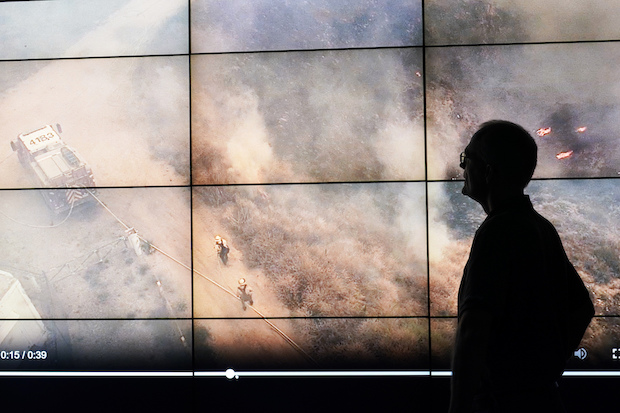Artificial Intelligence and Wildfires: How AI is Revolutionizing Firefighting
Falco Kuester, a researcher at ALERTCalifornia, a program run by the University of California San Diego, examines imagery of firefighters battling a fire from one of the program’s cameras in San Diego on Monday, Sept. 18, 2023. (Photo by GREGORY BULL / Associated Press)
LONDON — This summer, wildfires driven by climate change have devastated communities across the globe, from Maui to the Mediterranean, causing significant loss of life, exhausting firefighters, and increasing the demand for innovative solutions. This is where artificial intelligence (AI) comes in. Firefighters and startups are utilizing AI-powered cameras to scan the horizon for signs of smoke. A German company is developing a constellation of satellites to detect fires from space. Even Microsoft is employing AI models to predict potential fire outbreaks. As wildfires continue to grow in size and intensity due to global warming, it has become crucial for firefighters, utilities, and governments to harness the power of AI technology, which simultaneously invokes both fear and excitement for its transformative potential in our lives.
While first responders, who are already stretched thin, hope that AI can provide them with an edge, human validation is still necessary to ensure the accuracy of the technology. California’s main firefighting agency has recently begun testing an AI system that identifies smoke from over 1,000 mountaintop camera feeds and is planning to expand its implementation statewide. The system is designed to detect “abnormalities” and send alerts to emergency command centers, where personnel will verify if it is indeed smoke or something else in the air. Phillip SeLegue, staff chief of intelligence for the California Department of Forestry and Fire Protection, emphasizes the system’s efficiency by stating, “The beauty of this is that it immediately pops up on the screen, and those dispatchers or call takers are able to interrogate that screen and determine whether to send a crew.”
Pano AI, a San Francisco startup, operates in a similar manner by installing cameras on cell towers to scan for smoke and notify customers such as fire departments, utility companies, and ski resorts. The cameras employ computer vision machine learning, a form of AI, to detect smoke specifically. Sonia Kastner, CEO of Pano AI, explains that the cameras are trained using images of smoke and non-smoke to accurately identify the presence of smoke. The images are then combined with data from government weather satellites that scan for hotspots, as well as information from social media posts. This technology overcomes one of the primary challenges of traditional wildfire detection, which heavily relies on 911 calls from passers-by that require confirmation from staff before crews and water-dropping planes can be deployed. Kastner highlights the inefficiency of this approach by saying, “Generally, only one in 20 of these 911 calls are actually a wildfire. Even during fire season, it might be a cloud or fog or a barbecue.”
Pano AI’s system still relies on final confirmation, with managers reviewing a time-lapse of the camera feed to ensure that smoke is indeed rising. Larry Bekkedahl, senior vice president of energy delivery at Portland General Electric and a Pano AI customer, emphasizes the importance of technology in fighting forest fires, stating, “Technology is becoming really essential.” Utility companies, which can sometimes trigger wildfires when their power lines are damaged by wind or falling trees, have benefitted from this technology. Bekkedahl shares that Pano AI cameras have helped speed up response times and coordination with emergency services, allowing fire departments to quickly detect fires and deploy teams to the affected areas. This has resulted in response times being reduced by up to two hours, a significant improvement that can prevent fires from spreading and causing further damage.
Making use of AI to detect smoke from fires is relatively simple, according to Juan Lavista Ferres, chief data scientist at Microsoft. However, the challenge lies in deploying a sufficient number of cameras that cover vast and remote areas. Ferres and his team at Microsoft have been developing AI models to predict the likelihood of fire outbreaks. By training the models with maps of previously burned areas, along with climate and geospatial data, the system can identify patterns such as regions that are typically drier. While it cannot predict random events like lightning strikes, it leverages historical weather and climate data to generate probability maps based on past incidents. Microsoft plans to offer this technology as an open-source tool to assist first responders in determining where to allocate their limited resources.
Another company, German startup OroraTech, has taken a different approach by analyzing satellite images using AI to detect fires. Leveraging advancements in camera, satellite, and AI technologies, OroraTech has launched mini-satellites into low orbit around Earth. Equipped with efficient algorithms, these satellites provide thermal images, even at night when aerial drones are less active. Shortly after the launch of its second satellite, OroraTech detected a fire near the community of Keg River in northern Alberta, where large forested areas have repeatedly burned throughout the summer. By analyzing vegetation, humidity levels, and other factors, the AI can identify potential flare-ups that could lead to catastrophic megafires. Consequently, this innovative technology helps firefighting agencies optimize their resource allocation by focusing on the blazes that pose the greatest threat.
Artificial intelligence has undoubtedly become a game-changer in wildfire prevention and response. By harnessing AI-powered cameras, satellites, and predictive models, firefighters and emergency services can detect fires earlier, coordinate responses more efficiently, and ultimately minimize the damage caused by these devastating infernos. The future of firefighting lies in the integration of AI technology, providing hope in the face of an escalating crisis caused by climate change.
Denial of responsibility! Vigour Times is an automatic aggregator of Global media. In each content, the hyperlink to the primary source is specified. All trademarks belong to their rightful owners, and all materials to their authors. For any complaint, please reach us at – [email protected]. We will take necessary action within 24 hours.


